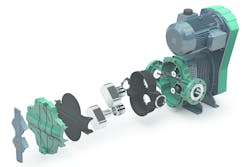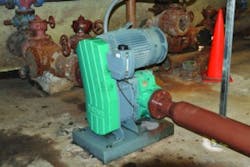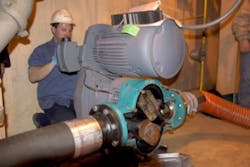Veolia Water North America manages the wastewater treatment processes for the city of Wilmington, Delaware. It assumed responsibility for operating, maintaining and managing the city’s solids-processing facilities in 1985.
In 1998, the company was also awarded a 20-year, $224-million contract to manage the entire wastewater treatment process for the city and outlying served areas.
Veolia Water North America supplies water and wastewater services to municipalities, government entities, businesses and industry.
Veolia recently improved the pumping solutions of two different sludge-handling applications: thickened-sludge transport and digester recirculation. It reduced its $250,000 annual pumps maintenance budget and downtime associated with issue-prone pumps.
By way of capital infrastructure, the contract includes operation of a 134-million-gallons-per-day high-rate activated sludge plant and three pump stations, with functions that include an industrial pretreatment program, industrial-leachate management and 11,000 dry-tons-per-day sludge disposal.
Like other older industrial cities, Wilmington boasts a combined sewer system, meaning that both sewage and storm water share common pipes as they flow to the Wilmington Wastewater Treatment Facility and eventually back into the Delaware River.
The very definition
Rotary lobe pumps are said to be versatile and used primarily in the environmental technology and the chemistry industry. They handle almost any substance continuously and gently while metering in proportion to speed. Small space requirements and high-power density are said to apply.
Lobe pumps are similar to external gear pumps. Fluid flows around the interior of the casing. Unlike external gear pumps, however, lobe contact is prevented by external timing gears located in the gearbox. Pump shaft support bearings are located in the gearbox, and because the bearings are out of the pumped liquid, pressure is limited by bearing location and shaft deflection.
As the lobes come out of mesh, they create expanding volume on the inlet side of the pump. Liquid flows into the cavity and is trapped by the lobes as they rotate. Liquid travels around the interior of the casing in the pockets between the lobes and the casing — it does not pass between the lobes. Finally, the meshing of the lobes forces liquid through the outlet port under pressure.
Particle size pumped can be much larger in lobe pumps than other positive-displacement types.
Anatomy of a problem
According to plant operators, two progressing-cavity pumps used in the thickened sludge transport application had pressure problems due to inferior design. The pumps displayed a very high angularity as a result of a short coupling rod and only grease-lubricated joints.
"One pump had a small dogbone, and it would snap all the time," says Aleksey Reznik, plant general manager, Veolia North America. "I would say that the longest running pumps we had would last about one year. We even had one pump that would go down every three months."
One rotary lobe pump replacement has run continuously for two years, with only two seal replacements.
A 90-day test was run using a lobe pump on the worst application: the feed line to the digesters with 3 to 4 percent solids at 60 pounds-per-square-inch pressure.
"We installed the 4-inch NETZSCH TORNADO T2 pump, and it has been running continuously for two years," Reznik says. "We’ve replaced two seals in that time, but with the easy access through the faceplate, that was a very simple operation."
The pump replaced a competitor’s progressing cavity pump. A second instance of the competitor’s pump was replaced by one sourced from yet another provider of traditionally designed rotary lobe pumps. Unfortunately, it wasn’t able to handle this heavy-duty application and was later also replaced by another T2 rotary lobe pump. To date, the two pumps operate 24 hours a day, seven days a week.
Digester circulation line
Because the rotary lobe pump is belt-driven, the only lubricating oil needed is for the seal.
In addition to thickened-sludge line issues, Veolia experienced gas-binding problems in some of the Wilmington plant’s sludge digesters.
"Before we installed the rotary lobe pumps, we used recessed impeller centrifugal pumps," says Frank DiPeitrapaul, a plant maintenance engineer. "There was a very long suction line, gas came through and the pumps continuously lost prime. When a pump lost prime, we had to back-flush the line by pumping water in, which is something you don’t want to do in this sludge application." The rotary lobe pump replacements have taken pressure off the small maintenance staff and brought a sense of order back to the maintenance schedule.
One replacement pump is 4 inches. The digesters open and close automatically, with some back-pressure as you go down the line. As a result of this higher pressure, the second pump is 6 inches.
Final words
The pumps have been in service six months in the sludge-circulation application without any downtime.
"Not only has the gas-binding problem been eliminated, but also, since the pump is belt-driven, there is no oil required," DiPeitrapaul says. "We don’t have to worry about putting in the wrong oil or running out of oil. There is a small container that puts a small amount of oil on the seal, but that’s it.”
Although staff checks the lobes regularly, no signs of wear are yet apparent. "In terms of maintenance, our team loves the pumps," he says. "The design is simple, and it takes about 15 minutes to check them over. Even when we had to repair the seals, it was easy because the design ensures that you don’t have to pull the pumps out for that kind of repair.” Additionally, the small footprint has benefits.
Pete Ciorrocco is Northeast regional sales manager for NETZSCH Pumps North America LLC, based in Exton, Pennsylvania.
For more than six decades, NETZSCH has developed, manufactured and marketed positive displacement pumps worldwide, from the smallest metering pumps to high-volume pumps for heavy industrial applications. It produces more than 50,000 pumps per year.


